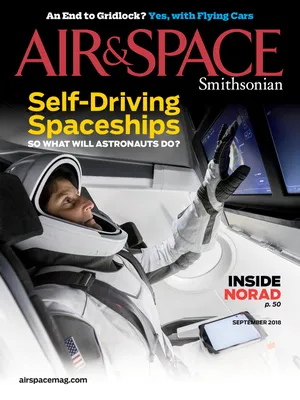The Making of 2001: A Space Odyssey
A new book reveals the drama that unfolded during the creation of an iconic film.
/https://tf-cmsv2-smithsonianmag-media.s3.amazonaws.com/filer/55/13/5513dfde-1e25-4a1e-a1ca-fc48b3771a53/2001_dullea.jpg)
To celebrate the 50th anniversary of 2001: A Space Odyssey (released in 1968), Michael Benson has written Space Odyssey: Stanley Kubrick, Arthur C. Clarke, and the Making of a Masterpiece, which chronicles the often-unorthodox quest undertaken by director Kubrick and screenwriter Clarke in creating one of the most controversial, influential films ever made. Benson spoke with Air & Space senior associate editor Diane Tedeschi in July.
Air & Space: Why did you decide to write this book?
Benson: I’ve been fascinated by 2001: A Space Odyssey since my mom took me to see it at the age of six. Much later, when I went to graduate film school [at New York University], I was keenly aware that for every film, there’s another narrative behind the one that unfolds on screen, and it’s all about the struggle to make the film itself. So when the 50th anniversary of the film appeared on the horizon, I was ahead of the game, and realized I’d better get my act together and write a book.
Why is the film a masterpiece?
2001 encompasses a staggering sweep of space and time. It covers four million years of human evolution, from pre-human man-ape to post-human “Star Child”—the name given the immense floating fetus seen arriving at Earth at the end. Plus, in its “Star Gate” sequence (the neo-psychedelic “trip”), 2001 seems to anticipate images sent to Earth by the Hubble Space Telescope starting in the 1990s: groundbreaking color images of distant nebulae and galaxies in incredible detail. But all that would be irrelevant if the story didn’t justify these things—and it did. 2001 manages to contain the past, present, and future of the human race, no less, and also managed to convey something of the power and beauty and mystery of the universe. These are not small achievements.
What can explain the discrepancy between the initial criticism of the film and its eventual acclaim?
There were several factors at play. One is that as with any radically innovative piece of work, it can take some time before the magnitude of the accomplishment sinks in. In other words, the initial impact is colored by the risks the [artist] has taken, which sometimes present challenges to audience acceptance. This was compounded by the fact that initial audiences were largely older, entitled members of the critical elite and entertainment world—people used to the old way of doing things. When it comes to big-budget Hollywood spectacles, that generally meant being spoon-fed narrative content. But 2001 is a largely nonverbal art film, a kind of big-budget exercise in experimental filmmaking, and the critics just weren’t prepared. Luckily, younger audiences were ready to embrace 2001, from day one, and that’s what made it the highest grossing film of 1968.
A second factor was that Kubrick cut almost 20 minutes of material after the initial screenings, removing some redundant scenes. After those cuts, critical reactions improved. So what we see today is not what the initial audiences saw.
Kubrick was something of a provocateur. What is the most shocking thing he did during the making of the film?
Well, as I believe my book brings out pretty well, in critical respects 2001 was an improvisation, from beginning to end. When they started shooting, Kubrick and Clarke didn’t even have a completed script, and they definitely didn’t have an ending. Plus, even the existing script, which was really nothing more than a treatment, was constantly being departed from and improved at the last minute. And by last minute, I mean the very morning when scenes were supposed to be shot. As production designer Tony Masters put it, it made the art department “suicidal.”
So what was the most shocking thing? That Kubrick engaged in what amounted to a high-stakes jazz improvisation in a film with a Hollywood budget equivalent to what a James Cameron or a Steven Spielberg has today. And instead of flaming out and potentially dragging MGM down with him—as Michael Cimino did a decade later with Heaven’s Gate and United Artists—he brought it off spectacularly.
What is one thing you learned about the making of the film that you hadn’t known?
Well, if I were to isolate one thing, it’d be the experience of stuntman Bill Weston, who, among other work on 2001, played the role of a spacewalking astronaut. The way Kubrick managed to create the illusion of weightlessness with near-total realism was by dangling Bill on a cable from the ceiling of a large soundstage swathed in black velvet, and then filming him from below as he performed quite elaborate—and quite dangerous—actions while dangling 30 feet above a concrete floor. This was all conducted without a net, by the way.
Compounding this was the fact that Kubrick didn’t let Weston punch air holes in the back of his helmet, because [Kubrick] was afraid light might leak into the helmet, destroying the illusion. As a result, Weston was hermetically sealed in his suit, with only a 10-minute supply of air bleeding into his helmet from a small tank. But even this didn’t really help, because the carbon dioxide he exhaled had nowhere to go. The result was he was forced to accomplish strenuous and difficult stunts while gradually graying out due to the effects of carbon dioxide poisoning. In one incident I document in my book, Weston actually passed out entirely when Kubrick refused to bring him in so he could get his shot. When he came to, he was furious and went off to find the director to teach him a lesson. But Kubrick had fled, and didn’t reappear in the studio for several days while his producers tried to calm Weston down. Which they eventually succeeded in doing, by giving him a fancy dressing room and a big raise.
What are some of the ways 2001 has influenced other filmmakers?
2001 marked the end of the Western as the predominant Hollywood genre and the beginning of the big-budget Hollywood science fiction spectacular. It’s a rare director that manages to change the entire course of film history in that way. Without 2001’s success, you wouldn’t have had Close Encounters, Star Wars, Alien, or innumerable other films. If we’re talking about influence, no other Kubrick project comes close. And people like Spielberg and Cameron are very open about how 2001 inspired them to become filmmakers. But from my point of view, 2001 has never been equaled, despite a lot of interesting attempts.
Does anything remain from the film, such as sets or costumes?
Not the sets, but some of the costumes and props. There’s a well-done 2001 anniversary exhibition at the German Film Museum in Frankfurt right now where you can see some of them.
Do you have a favorite character or scene?
Let me go with a scene: The deprogramming of the HAL 9000 supercomputer by the sole remaining Jupiter-bound astronaut, Dave Bowman, played by Keir Dullea. Bowman floats weightlessly within the computer’s “brain room.” As HAL pleads for his life, he’s methodically lobotomized. I think it’s one of the most powerful scenes in film history. HAL was voiced by Canadian actor Douglas Rain, who brought a kind of unbearable pathos.

